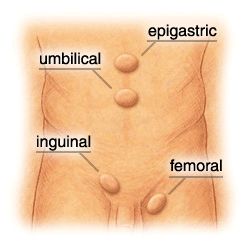
A hernia is a lump that results from a part of the intestine (bowel) slipping through a weakness in the abdominal wall. The most common hernias are inguinal hernias (groin hernias).
- indirect inguinal hernia which is common in children - they may be present at birth - and young people. They are mostly seen in males but can also occur in females
- direct inguinal hernias mostly afflict adults especially middle-aged and elderly men.
- femoral hernia is rarer than the other types and mainly affects women.
The opinion of a specialist doctor is usually necessary to determine which type of hernia is present.
The inguinal ligament is a tight band located between the thigh and the stomach and there are several weak spots along it. Obesity, pregnancy, heavy lifting, chronic coughing, constipation and straining to pass stools can cause the intestine to push against the abdominal wall, and a part of intestine may slip through a weak spot, creating a lump. This lump is called a hernia. A hernia consists of a sac - the peritoneum - which may contain a piece of intestine (an intestinal loop). It is often able to move inside your body, meaning that it disappears when you lie down, and reappears when you stand up or are straining to pass a stool. The hernia itself is harmless.
However, a hernia can be dangerous if it gets trapped in the weak spot in the abdominal wall and becomes tender. This is known as a strangulated hernia. If the intestinal loop is damaged, its contents can leak out. Gangrene and peritonitis, which can be life-threatening, may occur as a result. Strangulation is an emergency requiring urgent surgery.

An indirect inguinal hernia is located in the inguinal canal. In males, this is the location of the spermatic cord.
- Typically, the hernia is discovered when it descends into the scrotum.
- The hernia may be present at birth.
- The treatment for this type of hernia is removal through surgery. Although this can be performed immediately after birth, some surgeons prefer to wait until the child has reached the age of two. Surgery is also the standard treatment for older children and adults.
This type of hernia appears later in life.
- It is often two-sided.
- Obesity and hard physical work can contribute to its development.
- It can be seen and felt towards the middle of the inguinal ligament.
- Surgery is again the standard treatment for this type of hernia. Unfortunately, in many cases the hernia recurs and the surgery has to be repeated.
- When a very elderly person has a hernia, the doctors may decide not to operate if the hernia is unlikely to cause complications.
Femoral hernias are rare, and mostly seen in middle-aged and elderly obese women who have given birth several times.
- The hernia is seen as a lump below the inguinal ligament.
- The treatment is surgery.
Surgery is the only effective cure for a groin hernia.
In adults, surgery is only necessary if the hernia is causing discomfort or there is risk of strangulation.
Small direct inguinal hernias that are not causing any discomfort do not require surgery.
If the patient is fit enough for the operation, all indirect inguinal hernias and femoral hernias should be treated surgically.
The discomfort from direct and indirect inguinal hernia may be improved by a truss. This can be useful while the patient is waiting for an operation of if the patient is unfit for surgery. A truss, however, is not a cure.
The operation for a groin hernia is one of the commonest surgical procedures.
It is usually carried out under a general anaesthetic but a local anaesthetic, or a spinal anaesthetic can also be used.
Most operations are done through a cut in the groin which is three to four inches long. It can be on an outpatient basis or an overnight stay in hospital at the most.
Normal activities can usually be resumed within two weeks of the operation and the chance of a recurrence of the hernia after surgery is extremely small (less than 1 per cent).
The operation can also be performed using keyhole surgery. The only advantage of this is that patients can return to normal vigorous activity a little sooner. The long-term recurrence rate of hernias after keyhole surgery is not yet known.
If you or your child has a lump in the groin area, see a doctor. They can easily decide if it is a hernia and whether surgery is required.


 copy.jpg)

.jpg)